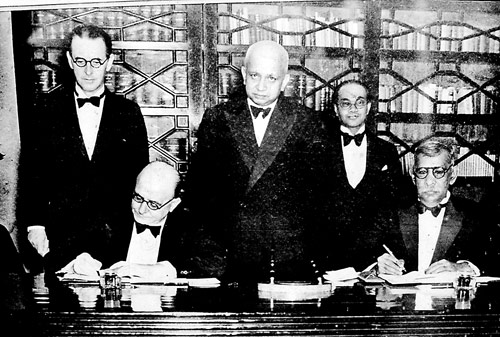How it all unfolded

A nation looks on in excitement and pride as Independence dawns with pomp and pageantry (file pix)
“The territory ceded by the Dutch was from 1797 to 1802 placed under the English East India Company, and formed a part of the territory of the Government of Madras until 1802, when Ceylon was created a Crown Colony. In 1815 the British Government declared war on the last king of Kandy. His mis-government had estranged his own subjects. He was able to offer but a feeble resistance, and was eventually taken prisoner. In terms of a convention held on 2nd March 1815, at Kandy, between the British authorities and the Kandyan chiefs, the king was dethroned, and the Sinhalese voluntarily surrendered their Island to the British sovereign with full reservation of their rights and liberties.
“Thus ended the oldest dynasty in the world, after enduring for twenty-four centuries, and the whole island passed under the sway of Britain. A few years ago at Tanjore in the Madras Presidency, I had the honour of being presented to the last surviving Queen of Kandy, who in spite of straitened means still maintained the traditions and ceremonial of a court. Speaking from behind a curtain, she was pleased to welcome me and express her appreciation of some little services rendered to her family since their downfall. She has now passed away. A lineal descendant of the kings of Ceylon holds a minor clerkship in the Registrar-General’s Department of this Island – a living testimony to the revolutions of the wheel of fortune.”
These two paragraphs are from a lecture delivered by Sir Ponnambalam Arunachalam (1853-1924), civil servant and national leader at the Legislative Council Chamber in Colombo presided by Governor Sir Henry A. Blake on January 30, 1906. At the start of the lecture titled, ‘Sketches of Ceylon History’ he said that “not only is the history of Ceylon among the oldest, most interesting and fascinating in the world, going back twenty-four centuries, but no people can break with its past as we are trying to do”. At the time of his writing the country was a Crown Colony under the British Empire following the British taking over the country from the Dutch.
As the years went by, national leaders successfully demanded that the country be granted Independence. Two of the key leaders in the campaign to gain freedom were E.W. Perera and D.B. (later Sir Baron) Jayatilaka, active members/presidents of the Ceylon National Congress formed in 1919. The two scholars lobbied the British government against actions of the colonial administration in the country. After them Don Stephen (D.S.) Senanayake led the constitutional movement and became the first Prime Minister of independent Sri Lanka.
Decades earlier, a commission had been appointed under Sir William Colebrooke when the British Government became anxious that finances were not being properly balanced. In 1833, on the Commission’s recommendation an Executive Council was appointed to control the acts of the Governor, and a Legislative Council, nominated by the Governor, to represent various interests and government departments.

Governor of Ceylon Sir Henry Monck-Mason Moore and Ceylon’s first Premier D.S. Senanayake signing the Independence document in 1948
After the opening up of plantation crops starting with coffee, the English business interests started agitating for constitutional reforms. The local intelligentsia too gradually began to realise the need for more participation in the administration. Patchwork was done by increasing the number of members of the Legislative Council at regular intervals but the agitators were not happy.
Realising that colonies could no longer be governed autocratically, the British Government decided to test out Ceylon with more reforms. The Donoughmore Commission was appointed to recommend changes. On the Commission’s recommendation the State Council was established in 1931.
When Governor Sir Andrew Caldecott arrived in 1937, he had instructions to study the constitutional position carefully taking into account the different opinions about the State Council system. The Governor recommended a Cabinet in place of the Board of Ministers, the elimination of the system of Executive Committees, and the retention of territorial representation which had replaced communal representation when members were elected to the State Council from 1931. It was coupled with the grant of universal adult suffrage when all male and female Ceylonese over 21 years were given the right to vote. This increased the voting population from 204,997 (based on educational and property qualification) to 2,175,000.
With the outbreak of World War II in 1939 no further reforms were put in place.
On May 26, 1943, it was declared that a post-war re-examination of the Ceylon Constitution would be made directed towards the grant of “full responsible government in all matters of civil administration”. Following this declaration the Secretary of State requested the Ministers who were agitating for self-government with other statesmen and organisations, to frame a constitution for examination.
A Commission appointed in September 1944 under Lord Soulbury recommended that a Westminster style of government be established with a bicameral legislature. On June 18, 1947, Governor Sir Henry Monck-Mason Moore made a statement at a special session of the State Council that “early steps will be taken by His Majesty’s Government as soon as the necessary arrangements are negotiated with the new Ceylon Government to confer upon this country fully responsible status within the British Commonwealth of Nations.”
On December 19, 1947, the Ceylon Independence (Commencement) Order in Council, 1947 was released at ‘the Court at Buckingham Palace’ declaring that “the appointed day for the purpose of the Ceylon Independence Act shall be the fourth day of February 1948”.
Thus did February 4 become our Independence Day.


